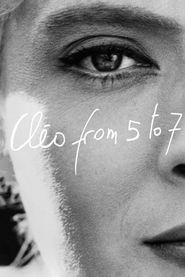Cléo from 5 to 7 is an odyssey that, like so many French films, is about the double delight of watching a beautiful woman against the backdrop of the most beautiful of cities, but it is also a spiritual journey from blindness to awareness, and from self- absorption to the possibility of love.
— Molly Haskell (Criterion)
Cléo could well be a Paris Hilton type, plugged into new-age fads (at one point, logically enough, Madonna was attached to a proposed remake).
[…]
The film is superbly playful, poking occasional holes in its own carefully built illusion of cascading moments—such as when an early shot of Cléo descending stairs is repeated, in an editing loop, three times (an evident reference to Duchamp’s Nude Descending a Staircase), or when she disappears behind a paravent to reappear instantly in a new outfit. Rich color gives way to black and white after the credits, one of many reminders of the artifice of cinema.
— Adrian Martin (Criterion)
If you want to consider the differences between men and women, consider that what Antoine says here was written by a woman, and many men would have found it out of reach.
By most accounts, photographer turned director Agnès Varda is considered the archetypal girl who crashed the big boys’ clubhouse, and Cléo from 5 to 7 was the film that paid her membership fee.
— Eric Henderson (Slant)
Two throwaway moments capture this changing sense of self nicely, especially when they’re considered as bookends. Early on, as a crowd of pedestrians waits to cross an intersection, Cleo brazenly steps past them into the street, confident she’ll be able to literally stop traffic. And she does. Later, however, after Cleo’s confidence has been chipped away by increasing worry, she tries to make her way through a line of pedestrians, but no one budges. They hardly notice her.
[…]
It would be dangerous to psychoanalyze too much of Cleo’s behavior […]. It isn’t the job of Cleo from 5 to 7 to explain all women, after all, or even this particular one. Simply being in her company, especially amidst the somewhat suffocating masculinity of the French New Wave, is enough.
— Josh Larsen (Larsen on Film)
The angle looks down at the cards, which appear in color, but every other scene [is] shown in black-and-white imagery takes on a narrow reality aligned with Cléo’s subjectivity.[…]
Looking in the mirror only confirms what others see.
[…]
Varda [] segments life into temporality by saturating every scene with objects that trace time: clocks, taxi meters, metronomes, and schedules measure out the temporal pieces of Cléo’s life. The devices have been carefully integrated into each scene without overemphasis, providing visual or aural evidence of Varda’s real-time conceit. […] But these structural devices do not represent objectivity or real-time filmmaking. Take when Cléo descends the stairs after her tarot card reading, and Varda repeats a moment of Cléo three times for emphasis—a poetic flourish that stands in the face of any claim to the film’s objectivity.
— Brian Eggert (Deep Focus Review)
High Noon done as a feminist high-art film.
— Thom Delapa (Cineaste, Winter 2024)
Synopsis: Agnès Varda eloquently captures Paris in the sixties with this real-time portrait of a singer set adrift in the city as she awaits test results of a biopsy. A chronicle of the minutes of one woman’s life, Cléo from 5 to 7 is a spirited mix of vivid vérité and melodrama, featuring a score by Michel Legrand and cameos by Jean-Luc Godard and Anna Karina.

